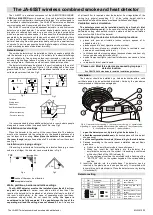
7
Applying this principle, a VCM (voice coil motor) is used to apply a horizontal force to an object of weight W as
illustrated in Diagram 2. The object will begin to move the instant that the force thus applied exceeds the force
of friction. The force (F) generated at this time is obtained by the formula F = ki. Therefore, the coefficient of
static friction is obtained by the formula ki/W.
k : Constant force applied by the VCM
i : Current at the instant the object began to move.
W : Weight of the object (g)
4. Measurement Principle
Static friction is generally measured using the incline method. As illustrated in Diagram 1 below, when an
object of weight W is placed upon a surface which is gradually inclined at an increasing angle, at some angle
of inclination the acceleration of gravity acting upon the object will exceed the static friction which tends to
keep the object in place and the object will begin to slip. This angle q (theta) is referred to as the friction angle.
Taking µs as the coefficient of static friction, the force of friction is the vertical force with which the object
pushes down upon the surface (Wcosq) and the area µs (µsWcosq). Therefore, the force with which the object
tends to slip down the slope (Wsinq) is thus tanq. In this way, the coefficient of static friction can be obtained
by measuring the friction angle q.
Diagram 1
Diagram 2
Wsin
θ
=µsWcos
θ
µs=Wsin
θ
/Wcos
θ
=tan
θ
Wtan
θ
=µsW
µs=Wtan
θ
/W=tan
θ






































